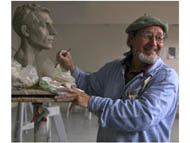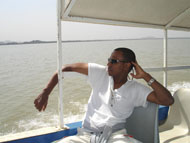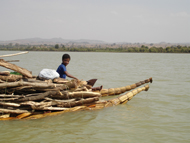Impressions of Stone Sculpture Around Marble Mountain, Vietnam - May/June 2007
- Details
- Created: Wednesday, 02 May 2007 05:21
Vietnam is industry in action, a country in the process of reinventing itself. Everywhere you look you see people busy making something or selling something. As we left Da Nang on our way to Hoi An, we stopped at Marble Mountain, a village situated in the midst of five mountains each named for the five elements. Marble Mountain itself is filled with caves and grottoes that include a magnificent statue of Quan Yin.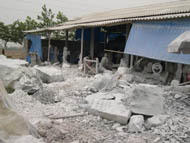
At the foot of the Mountain, the town is a cacophony of grinders, cutting wheels, chisels and hammers. You can taste the marble dust in the air. Open-air studios are filled with stone carvers. In front of the studios are small shops where you can buy marble Buddhas, embracing couples, stallions, unicorns, abstract shapes. Four men walked through town carefully moving a 15-foot tall Virgin Mary statue on a simple ox cart (sans ox). Masons and carvers have been working in this area for generations. Hand tools were the norm until Americans brought electricity to the area during what the Vietnamese call the American War. My friend Ken was one of the US Army grunts who did that work in the 1960s. The electrical infrastructure has been well maintained and utilized by the carvers ever since.
It was common to see 10-20 people working in a sculpture factory. We saw workers rough-forming stone with point chisels and hammers, while others worked with angle and die grinders fitted with grinding or cutting wheels. Most people seemed to be journeymen or apprentices under the watchful eye of the shop master. The master would periodically walk the shop, look at a workers’ progress, stop and mark a piece with a crayon to indicate what to cut away next. Men were doing the stone carving. Women were sanding and polishing. While some people wore cloth masks or handkerchiefs for respirators, no one was wearing ear protection. (Imagine the din of 15 angle grinders in a small space.) Everyone wore open-toed sandals or flip-flops. Gerry-rigged extension cords provided power and small plastic lines brought water to cool tools and stone. Some sculptors perched atop their work, focusing on specific areas. Two or three people might be working on a large rough piece. As the piece took shape, one craftsman worked alone.
I witnessed a lovely seated Buddha nearing completion. It was a beautiful white marble piece about 5 feet tall, laying on it’s back with the head propped up. The master sculptor watched as the journeyman cleaned every last speck on the Buddha’s face with a rotary tool (Dremel® size). Then the master stepped in. With a fine mechanical pencil, he sketched in the eyes, giving them the classic downcast gaze. He deftly wielded the rotary tool. In a few minutes the blind face had vision and the sublime look of enlightenment.
The majority of Vietnamese stone carvers believe that if one fu dog sells, hundreds more just like it will sell as well. Walking studio to studio in Marble Mountain, one can see better renditions in some places. But, they are just that—renditions—similar versions of the same set of images.
In Vietnam they have a phrase they say to foreign visitors: “Same Same.” And Same Same is regarded as a good thing. Individual creativity is a luxury of self-expression that isn’t part of the Vietnamese paradigm. They tend to think as a collective, not as individuals. We did meet some painters who were striking out on their own, but most sculptors’ work seemed to be recreations of antique Chinese and Vietnamese statuary, or heroic Soviet-style large works, etc. The sculpture park that lines both sides of the river in Hue really underscores this. Interesting work, but I think another generation or two of sculptors needs to ‘come up’ before we will start seeing a sculptural language that is uniquely expressing the artist’s vision.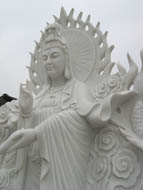
In Hoi An, we met a Swiss sculptor who had recently emigrated. He calls his shop Saladery. He lives in the loft over his shop and spent his days sculpting in his Marble Mountain studio. Using the well-developed system of Vietnamese craftsmen, he is able to make small editions of his sculptures in short order. He loves his life in Hoi An and lamented, “I spent 20 years in the wrong country.”
Photography by Morgan Ray and Jonna Ramey

